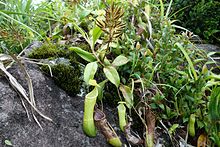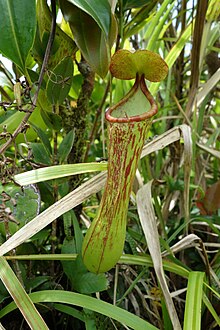Nepenthes ramos
| Nepenthes ramos | |
|---|---|

| |

| |
| Scrambling plant (top) and upper pitcher from Mount Hibok-Hibok, Camiguin | |
| Scientific classification | |
| Kingdom: | Plantae |
| Clade: | Tracheophytes |
| Clade: | Angiosperms |
| Clade: | Eudicots |
| Order: | Caryophyllales |
| Family: | Nepenthaceae |
| Genus: | Nepenthes |
| Species: | N. ramos
|
| Binomial name | |
| Nepenthes ramos | |
| Synonyms[3][4] | |
Nepenthes ramos is a tropical
Nepenthes ramos belongs to the informal "N. alata group", which also includes
The
Plants matching the description of N. ramos have been observed in the Mindanao provinces of
Nepenthes kurata
Nepenthes kurata was described in 2013 as a species known only from
The specific epithet kurata honours botanist Shigeo Kurata, best known for his 1976 book, Nepenthes of Mount Kinabalu.[3]
Nepenthes kurata was formally synonymised with N. ramos in 2016.[4]
References
- ^
- ^ a b Macfarlane, J.M. (1908). Nepenthaceae. In: A. Engler. Das Pflanzenreich IV, III, Heft 36: 1–91.
- ^
- ^
- ^
- ^ a b Gronemeyer, T. (2015). Nepenthes ramos located in the field Archived 2018-02-24 at the Wayback Machine. Carnivorous Plants in the tropics, 5 January 2015.
- ^ (in German) Gronemeyer, T. (2014). Nepenthes ramos am Naturstandort. G.F.P. Forum, November 29, 2014.
- Mey, F.S. (2013). Nepenthes alzapan and an army of new species from the Philippines. Strange Fruits: A Garden's Chronicle, July 15, 2013.
- (in German) Micheler, M., T. Gronemeyer, A. Wistuba, D. Marwinski, W. Suarez & V. Amoroso (2013). Nepenthes viridis, eine neue Nepenthes-Art von der Insel Dinagat, Philippinen. Das Taublatt 76: 4–21.
- Smith, L. (2014). Pitcher perfect - but carnivorous plants are at risk. The Independent, January 5, 2014.
